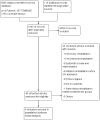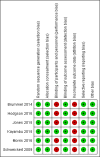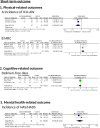Early rehabilitation to prevent postintensive care syndrome in patients with critical illness: a systematic review and meta-analysis
- PMID: 29730622
- PMCID: PMC5942437
- DOI: 10.1136/bmjopen-2017-019998
Early rehabilitation to prevent postintensive care syndrome in patients with critical illness: a systematic review and meta-analysis
Abstract
Introduction: We examined the effectiveness of early rehabilitation for the prevention of postintensive care syndrome (PICS), characterised by an impaired physical, cognitive or mental health status, among survivors of critical illness.
Methods: We performed a systematic literature search of several databases (Medline, Embase and Cochrane Central Register of Controlled Trials) and a manual search to identify randomised controlled trials (RCTs) comparing the effectiveness of early rehabilitation versus no early rehabilitation or standard care for the prevention of PICS. The primary outcomes were short-term physical-related, cognitive-related and mental health-related outcomes assessed during hospitalisation. The secondary outcomes were the standardised, long-term health-related quality of life scores (EuroQol 5 Dimension (EQ5D) and the Medical Outcomes Study 36-Item Short Form Health Survey Physical Function Scale (SF-36 PF)). We used the Grading of Recommendations Assessment, Development and Evaluation approach to rate the quality of evidence (QoE).
Results: Six RCTs selected from 5105 screened abstracts were included. Early rehabilitation significantly improved short-term physical-related outcomes, as indicated by an increased Medical Research Council scale score (standardised mean difference (SMD): 0.38, 95% CI 0.10 to 0.66, p=0.009) (QoE: low) and a decreased incidence of intensive care unit-acquired weakness (OR 0.42, 95% CI 0.22 to 0.82, p=0.01, QoE: low), compared with standard care or no early rehabilitation. However, the two groups did not differ in terms of cognitive-related delirium-free days (SMD: -0.02, 95% CI -0.23 to 0.20, QoE: low) and the mental health-related Hospital Anxiety and Depression Scale score (OR: 0.79, 95% CI 0.29 to 2.12, QoE: low). Early rehabilitation did not improve the long-term outcomes of PICS as characterised by EQ5D and SF-36 PF.
Conclusions: Early rehabilitation improved only short-term physical-related outcomes in patients with critical illness. Additional large RCTs are needed.
Keywords: early rehabilitation; intensive care unit; post-intensive care syndrome; sepsis.
© Article author(s) (or their employer(s) unless otherwise stated in the text of the article) 2018. All rights reserved. No commercial use is permitted unless otherwise expressly granted.
Conflict of interest statement
Competing interests: None declared.
Figures




References
Publication types
MeSH terms
LinkOut - more resources
Full Text Sources
Other Literature Sources
Medical
